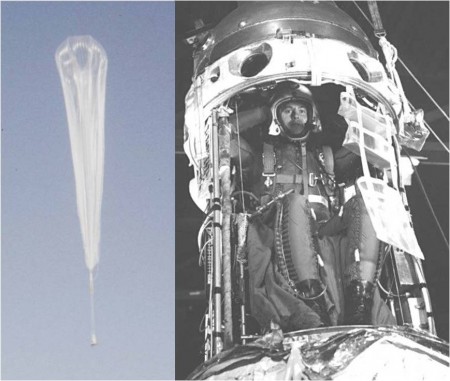Fifty-four years ago today, USAF Lt Clifton M. McClure successfully completed the Manhigh III aeromedical mission in which he reached an altitude of 98,000 feet. During the descent phase of his nearly-12 hours aloft, McClure’s core body temperature reached an astounding 108.6 F.
Project Manhigh was a United States Air Force biomedical research program that investigated the human factors of spaceflight by taking men into a near-space environment. Preparations for the trio of Manhigh flights began in 1955. The experience and data gleaned from Manhigh were instrumental to the success of the nation’s early manned spaceflight effort.
The Manhigh target altitude was approximately 100,000 feet above sea level. A helium-filled polyethylene balloon, just 0.0015-inches thick and inflatable to a maximum volume of over 3-million cubic feet, carried the Manhigh gondola into the stratosphere. At float altitude, this balloon expanded to a diameter of about 200 feet.
The Manhigh gondola was a hemispherically-capped cylinder that measured 3-feet in diameter and 8-feet in length (increased to 9-feet for Manhiogh III). It was attached to the transporting balloon via a 40-foot diameter recovery parachute. Although compact, the gondola was amply provisioned with the necessities of flight including life support, power and communication systems. It also included expendable ballast for use in controlling the altitude of the Manhigh balloon.
The Manhigh test pilot wore a T-1 partial pressure suit during the Manhigh mission. This would protect him in the event that the gondola cabin lost pressure at extreme altitude. The pilot was hooked-up to a variety of sensors which transmitted his biomedical information to the ground throughout the flight. This allowed medicos on the ground to keep a constant tab on the pilot’s physical status.
The first two Manhigh missions were flown in 1957. USAF Captain Joseph W. Kittinger reached an altitude of 95,200 ft during the 6-hour, 32-minute Manhigh I mission of Sunday, 02 June 1957. USAF Major David G. Simons flew the 32-hour, 10-minute mission of Manhigh II on Sunday-Monday, 18-19 August 1957. Simons soared to a Project Manhigh record altitude of 101,516 feet.
Manhigh III was launched from Holloman Air Force Base in New Mexico on Wednesday, 08 October 1958. USAF Lt Clifton M. McClure was the pilot and research specimen for the mission. The huge Manhigh balloon lifted-off with McClure and his dimunitive capsule at 1151 UTC. The trip upstairs took roughly 3 hours and resulted in a float altitude of 98,000 feet.
Interestingly, a launch attempt the day before had been aborted when a wind gust tore the thin mylar balloon while the ground crew was preparing it for launch. The next day, as McClure awaited launch within the Manhigh III capsule, his chest-mounted emergency parachute inexplicably ejected and plopped into the pilot’s lap. Incredibly, McClure repacked the parachute (not once, but twice) and managed to avoid another mission abort.
Clifton McClure uneventfully went through his Manhigh flight plan until ground control noticed that the pilot was evidencing signs of degraded performance. The pilot’s pulse rate and core body temperature were elevated as well. It turned out that McClure had not ingested any water fover the previous 11 hours! However, after being instructed to hydrate himself, McClure could only get a few drops of water at a time due to a problem with his drinking tube. Within 10 minutes, he had fixed the problem and could then drink freely.
A significant reason that McClure’s body temperature began to rise was due to ineffective cooling of the Manhigh III capsule. On previous Manhigh missions, the capsule dome was repacked with dry ice just prior to launch. However, on Manhigh III, a decision was made to dispense with the repacking procedure. The result was that the heat generated by the Manhigh pilot’s body and capsule systems ultimately exceeded the cooling capacity of the environmental control system.
Around 1900 UTC, the decision was made to end the mission and bring McClure down. However, the trip back to Earth was excruciatingly slow. By 2100 UTC, the capsule was still at 87,000 feet and McClure’s core body temperature had risen to 104.1 F. It was all McClure could to just to remain conscious as his body temperature continued to soar. Finally, at 2342 UTC, the Manhigh III capsule settled onto the desert floor. In spite of the fact that McClure’s internal body temperature registered a phenomenal 108.6 F, the pilot egressed the Manhigh capsule under his own power.
During his Manhigh III experience, Clifton McClure exceeded by 137 percent what was then thought to be the limit for human heat tolerance. He received the USAF Distinguished Flying Cross in recognition of his superlative performance. Following his military career, McClure plied the engineer’s trade until retirement. Clifton M. McClure passed away in January of 2000 at the age of 68.

